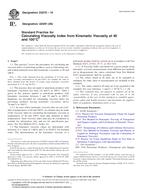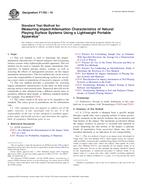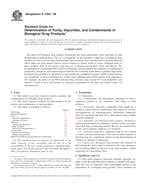ASTM D2270-10
- Standard Practice for Calculating Viscosity Index From Kinematic Viscosity at 40 and 100 degrees C
- standard by ASTM International, 10/01/2010
- Publisher: ASTM
$26.00$52.80
1.1 This practice covers the procedures for calculating the viscosity index of petroleum products, such as lubricating oils, and related materials from their kinematic viscosities at 40 and 100°C.
Note 1 - The results obtained from the calculation of VI from kinematic viscosities determined at 40 and 100°C are virtually the same as those obtained from the former VI system using kinematic viscosities determined at 37.78 and 98.89°C.
1.2 This practice does not apply to petroleum products with kinematic viscosities less than 2.0 mm²/s at 100°C. Table 1 given in this practice applies to petroleum products with kinematic viscosities between 2 and 70 mm²/s at 100°C. Equations are provided for calculating viscosity index for petroleum products having kinematic viscosities above 70 mm²/s at 100°C.
1.2.1 In cases where kinematic viscosity data are not available at temperatures of 40 and 100°C, an estimate may be made of the viscosity index by calculating the kinematic viscosity at temperatures of 40 and 100°C from data obtained at other temperatures. Such viscosity index data may be considered as suitable for information only and not for specification purposes. See Test Method D341, Annex A1.
1.3 The kinematic viscosity values are determined with reference to a value of 1.0034 mm²/s at 20.00°C for distilled water. The determination of the kinematic viscosity of a petroleum product shall be carried out in accordance with Test Methods D445, D7042, IP 71, or ISO 3104.
1.3.1 If Viscosity Index calculated for a given sample using kinematic viscosity measurements from different test methods are in disagreement, the values calculated from Test Method measurements shall be accepted.
1.4 The values stated in SI units are to be regarded as standard. No other units of measurement are included in this standard.
1.4.1 The values stated in SI units are to be regarded as the standard. For user reference, 1 mm²/s = 10-6m²/s = 1 cSt.
1.5 This standard does not purport to address all of the safety concerns, if any, associated with its use. It is the responsibility of the user of this standard to establish appropriate safety and health practices and determine the applicability of regulatory limitations prior to use.
Related Products
ASTM F1702-10
Standard Test Method for Measuring Impact-Attenuation Characteristics of Natural Playing Surface Sy..
$22.00 $44.00
ASTM C490-00a
Standard Practice for Use of Apparatus for the Determination of Length Change of Hardened Cement Pas..
$26.00 $52.80
ASTM E1298-06
Standard Guide for Determination of Purity, Impurities, and Contaminants in Biological Drug Products..
$23.00 $46.80




